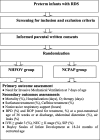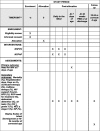Non-invasive high-frequency oscillatory ventilation versus nasal continuous positive airway pressure in preterm infants with respiratory distress syndrome: Study protocol for a multi-center prospective randomized controlled trial
- PMID: 29898763
- PMCID: PMC6001134
- DOI: 10.1186/s13063-018-2673-9
Non-invasive high-frequency oscillatory ventilation versus nasal continuous positive airway pressure in preterm infants with respiratory distress syndrome: Study protocol for a multi-center prospective randomized controlled trial
Abstract
Background: Invasive mechanical ventilation (IMV) is associated with the development of adverse pulmonary and non-pulmonary outcomes in very premature infants. Various modes of non-invasive respiratory support are increasingly being used to decrease the incidence of bronchopulmonary dysplasia. The aim of this trial is to compare the effect of non-invasive high-frequency oscillatory ventilation (NHFOV) and nasal continuous positive airway pressure (NCPAP) in preterm infants with respiratory distress syndrome (RDS) as a primary non-invasive ventilation support mode.
Methods/design: In this multi-center randomized controlled trial, 300 preterm infants born at a gestational age of 266/7 to 336/7 weeks with a diagnosis of RDS will be randomized to NHFOV or NCPAP as a primary mode of non-invasive respiratory support. The study will be conducted in 18 tertiary neonatal intensive care units in China. The primary outcome is the need for IMV during the first 7 days after enrollment in preterm infants randomized to the two groups. The prespecified secondary outcomes include days of hospitalization, days on non-invasive respiratory support, days on IMV, days on supplemental oxygen, mortality, need for a surfactant, severe retinopathy of prematurity requiring laser treatment or surgery, patent ductus arteriosus needing ligation, bronchopulmonary dysplasia, abdominal distention, air leak syndromes, intraventricular hemorrhage (≥ grade 3), spontaneous intestinal perforation, necrotizing enterocolitis (≥II stage), and nasal trauma. Other secondary outcomes include Bayley Scales of Infant Development at 18-24 months of corrected age.
Discussion: In recent decades, several observational studies have compared the effects of NHFOV and NCPAP in neonates as a rescue mode or during weaning from IMV. To our knowledge, this will be the first multi-center prospective, randomized controlled trial to evaluate NHFOV as a primary mode in preterm infants with RDS in China or any other part of the world. Our trial may help to establish guidelines for NHFOV in preterm infants with RDS to minimize the need for IMV, and to decrease the significant pulmonary and non-pulmonary morbidities associated with IMV.
Trial registration: ClinicalTrials.gov, NCT03099694 . Registered on 4 April 2017.
Keywords: Invasive mechanical ventilation; Nasal continuous positive airway pressure; Non-invasive high-frequency oscillatory ventilation; Preterm infants; Respiratory distress syndrome; Surfactant.
Conflict of interest statement
Authors’ information
These are the participating centers and investigators of the NHFOV Study Group:
Daping Hospital, Research Institute of Surgery, Third Military Medical University, Chongqing, 400,042, China
○ Xing-Wang Zhu, MD, 15084335697@163.com
○ Yuan Shi, MD, PhD, FAAP, petshi530@163.com
- 2.
Children’s Hospital of Chongqing Medical University, Chongqing, 400,020, China
○ Lei Bao, MD, cqbl0046@163.com
○ Cheng-Jun Liu, MD, liucwd@163.com
- 3.
The Children’s Hospital of Zhejiang University School of Medicine, Hangzhou, 310,000, China
○ Li-Ping Shi, MD, slping2008@163.com
- 4.
The Second Hospital of Shandong University, Jinan, 250,000, China
○ Jiang Xue, MD, sdxj69@163.com
- 5.
Chengdu Women and Children’s Central Hospital, Chengdu, 610,000, China
○ Rong Ju, MD, jurong123@126.com
- 6.
Guiyang Maternity and Child Health Care Hospital, Guiyang, 550,000, China
○ Ling Liu, MD, liulingped@sina.com
- 7.
Hunan Children’s Hospital, Changsha, 410,000, China
○ Xi-RongGao, MD,gaoxirong@126.com
- 8.
Chongqing Maternal and Child Health Hospital, Chongqing, 401,120, China
○ Xiao-Yun Zhong, MD, 13883519380@163.com
- 9.
Zhengzhou Children’s Hospital, Zhengzhou, 450,000, China
○ Hui-Qing Sun, MD, s_huiqing@sina.com
- 10.
Kunming Children’s Hospital, Kunming, 650,000, China
○ Yang-Fang Li, MD, lyf61@126.com
○ Kun Du, MD, dukun@etyy.cn
- 11.
Yan’an Affiliated Hospital of Kunming Medical University, Kunming, 650,000, China
○ Hong Cao, MD, 1206794997@qq.com
- 12.
The People’s Hospital of DehongAutonomous Prefecture, Dehong, 678,400, China
○ Zhao-qing Yin, MD, zhaoqingyin99@sina.com
- 13.
Chongqing Three Gorges Central Hospital, Chongqing, 404,100, China
○ Ming Yi, MD, yimingd123@126.com
- 14.
Jiulongpo People’s Hospital, Chongqing, 400,024, China
○ Xing-Wang Zhu, MD, 15084335697@163.com
○ Jun Yan, MD, chutiangechina@sina.com
- 15.
Shanxi Provincial Maternity and Children’s Hospital, Xi’an, 710,000, China
○ Zhan-Kui Li, MD, Lzk5808@163.com
- 16.
Guangdong Women and Children Hospital, Guangzhou, 510,000, China
○ Wei-Wei Gao, MD, mgbbbear@qq.com
- 17.
Nanjing Children’s Hospital, Nanjing, 210,000, China
○ Rui Cheng, MD, 18951769507@163.com
- 18.
Children’s Hospital of Fudan University, Shanghai, 200,000, China
○ Lai-Shuan Wang, MD, laishuanwang@163.com
- 19.
Vilnius Maternity Hospital, Vilnius, Lithuania
○ Vladimiras Chijenas, MD, vladimirasc@gmail.com
- 20.
LAC + USC Medical Center, Keck School of Medicine, University of Southern California, Los Angeles, California, USA
○ Rangasamy Ramanathan. MD, ramanath@usc.edu
Ethics approval and consent to participate
The trial has been approved by the ethics committee of Daping Hospital and the Research Institute of Surgery of the Third Military Medical University, and the institutional review boards of each of the participating centers. Informed parental consent will be obtained prior to any study-related procedures. The trial investigators and institutions will permit trial-related monitoring, audits, research ethics committee review, and regulatory inspections, by providing direct access to source data and documents. Trial participants are informed of this during the informed consent discussion. The trial will be run in accordance with good clinical practice and current regulatory guidance.
Consent for publication
Consent for publication is not applicable. Participants will not be identified by name on any documents or in connection with any data that leave the study sites, nor will they be reported by name in any report or publication resulting from data collected in this study.
Competing interests
The authors declare that they have no competing interests.
Publisher’s Note
Springer Nature remains neutral with regard to jurisdictional claims in published maps and institutional affiliations.
Figures
References
-
- Cumming JJ, Polin RA, AAP the COMMITTEE ON FETUS AND NEWBORN. Noninvasive respiratory support. Pediatrics. 2016;137(1). 10.1542/peds.2015-3758. Epub 2015 Dec 29 - PubMed
-
- Stefanescu BM, Murphy WP, Hansell BJ, Fuloria M, Morgan TM, Aschner JL. A randomized, controlled trial comparing two different continuous positive airway pressure systems for the successful extubation of extremely low birth weight infants. Pediatrics. 2003;112:1031–1038. doi: 10.1542/peds.112.5.1031. - DOI - PubMed
Publication types
MeSH terms
Associated data
Grants and funding
LinkOut - more resources
Full Text Sources
Other Literature Sources
Medical
Miscellaneous



